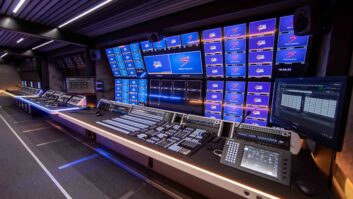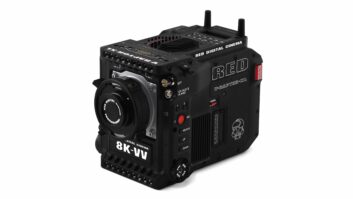
Founded in 2004, Sequence Post started life with a background in extreme sports. The company was based around the emergence of Final Cut Pro and lightweight Mac technology and was the first post house to employ it, says Ben Foakes (pictured right), managing director. After spending five years at Pinewood Studios, where the post house built up valuable film connections, Sequence made the move to central London in 2009. It has since grown and now occupies four floors with seven operational suites and two DaVinci grading theatres. “As well as Final Cut Pro and being Mac-based, we also offer Avid and Adobe Premiere. We’ve taken an agnostic approach to editing. “In all of our suites, you log in and choose which application you need and off you go. When it comes to monitoring, every room is full HD, full online suite quality for finishing and broadcast delivery,” he explains. Sequence Post completed a £250,000 upgrade in December last year in just 10 days, the first phase of a larger expansion plan. “Because we’ve been relying on FCP7 for so long and that had become defunct really, I wanted to invest money to update all of the NLE software. In order to make that work we had to put in a whole new server system and replace our fibre with a Cat 6a Ethernet network. We took the downtime to do servicing of the Macs, decorating and infrastructure tweaks.” As part of the refit, Sequence added to its high-grade monitor count with two new Penta displays. Foakes explains that Oxygen DCT has been supplying the post house for five years. 2008 was a time when Sequence was working on projects such as the end titles for Quantum of Solace and the Red Bull Air Race. HD had kicked in and post production companies were making the switch. “The reason I went with Penta displays was at the time down to price point because my options for a Sony for the same image quality was going to cost £20,000. It was really good value for money versus what it would give us in the suites. As we grew and because it worked so well we fitted them out into every room.” Quality monitoring Totalling seven Penta monitors now, Sequence purchased the two extra monitors during the Christmas upgrade — a 47-inch 16-bit screen for the grading room and a 24-inch for one of the online cutting rooms. “Every suite now has one including the ingest and QC stations for the assistant editors. I think that’s quite unique – even the most basic workstation for digitising has one so we know everything we’re looking at is super accurate.” Steve Hathaway (pictured left), director of Oxygen DCT, adds: “What’s unique to us about Sequence’s approach to quality is that they’ve taken a conscious decision to elevate themselves to have reference quality monitoring in all their suites. So whichever room you go in the colours are exactly right. They’re able to reassure their clients that what they’re looking at is accurate to international standards and local and national practices.” Speaking on the benefits of the Penta monitors, Hathaway remarks: “If the image quality on the screen doesn’t look quite right you can look back into the acquisition side [where the images came from] and determine if they were shot correctly because they’re being looked at using reference quality. A number of people in our experience do that QC stage at the end of the edit. Whereas by using the higher quality screens during the edit it means you don’t need to go to the QC stage, although inevitably everyone does, so you’re doing it higher up the workflow chain. This therefore eliminates process and having to go back and redo things later on so it saves money.” Another benefit is correct colours to industry standard, Hathaway points out. “Having them in every room means there is consistency in each suite.” Oxygen DCT also provides a recalibration service to Sequence to make sure the standards are exactly right as monitors suffer wear and tear. Using a £10,000 probe (Konica Minolta CS200 Colour spectrum analyser accurate to within 0.1Cd brightness), originating from the medical industry, it measures if the media has been shot with the right colour or if the back focus on the camera is right. “We have 14 different HD formats and legacy SD so camera people have the opportunity to get the colours wrong far greater now than before,” Hathaway explains. Screen versus projection Copy:So why did Sequence Post choose big screen wall mounts? “There’s a convergence going on between TV, commercial and film production and everyone is gravitating towards things like the Arri Alexa camera. It’s probably the most common high-end format we’ll receive. “Instead of going down the optical projection route, I decided to go for a screen in our grading rooms because 99% of what we do is video based. It’s not too long until everything will be video based. That’s why I think calibrated grade 1 screens are better than projection. You don’t get the grandiose cinema feel but it’s still pretty epic,” says Foakes. According to Hathaway, Penta is the first to make a 10-bit 47-inch LCD monitor. “It’s very pioneering and leading.” He reveals that the BBC has adopted 47-inch Penta monitors for grading work too. “It’s LCD, not OLED which means you’re showing the full true picture rather than a picture that has been manipulated to look good.” “Traditionally QC before transmission would be the responsibility of the broadcaster but now broadcasters are pushing it back to the production companies who need to be responsible for their own QC,” says Foakes. This will in turn put more technical pressure on post houses to be as accurate as possible with their deliveries. We’re moving towards a file-based industry where eventually we’ll be pinging MXF files over the internet straight to the broadcaster,” says Foakes. “The human element is going to gradually diminish as automation becomes more prevalent and that will put more pressure on us as there’ll be no room for error. So the importance of having the correct monitoring from the day the footage comes in to when it hits file delivery is so important. Probably more so than ever before.”







